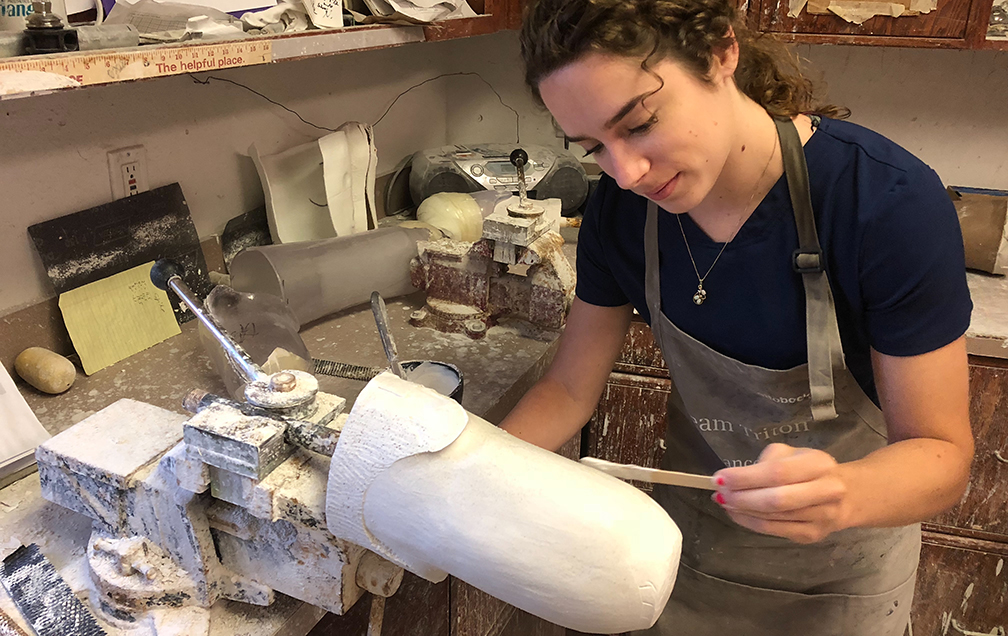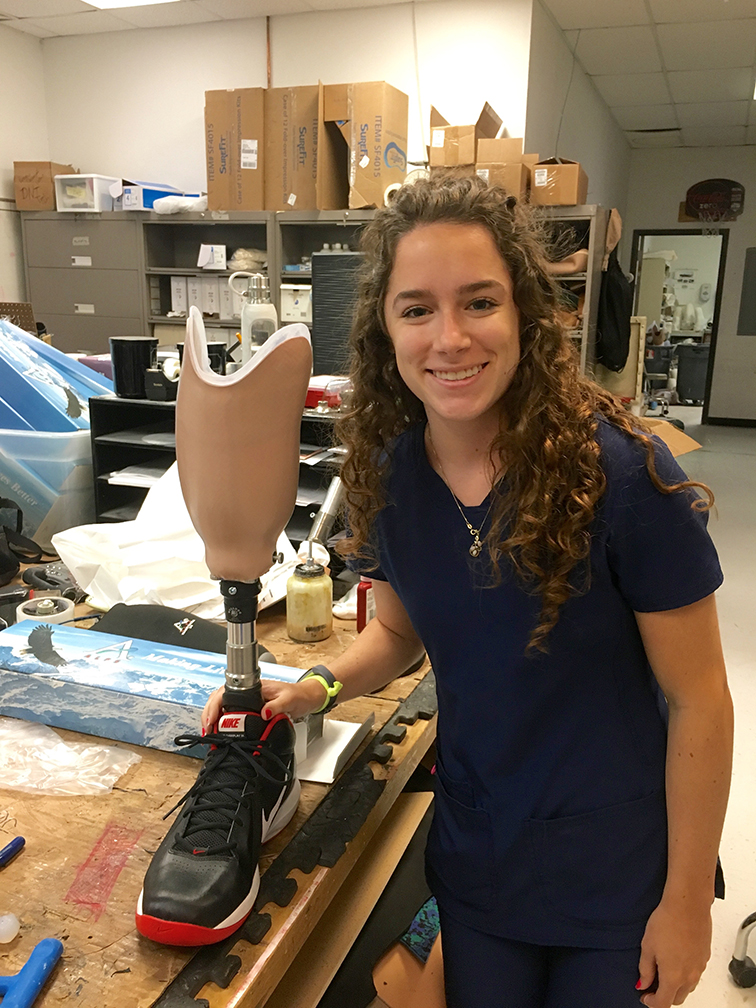Father Inspires BAE Senior to Study Prosthetics
 BATON ROUGE – LSU Biological and Agricultural Engineering student Emily Patterson
always knew she wanted to work in a field where she could help people, but never did
she realize just how personal that endeavor would become. Going into her senior year
studying prosthetics, Patterson is making it her mission to change the lives of people
without the use of their limbs—people like her father.
BATON ROUGE – LSU Biological and Agricultural Engineering student Emily Patterson
always knew she wanted to work in a field where she could help people, but never did
she realize just how personal that endeavor would become. Going into her senior year
studying prosthetics, Patterson is making it her mission to change the lives of people
without the use of their limbs—people like her father.
“I always knew I wanted to help people and do something in the medical field, but I also enjoyed the math and science behind engineering,” said Patterson, a native of Prairieville, La. “The greatest fit to me was biological engineering, and I felt like prosthetics was a good combo.”
There was, however, another inspiration for her choosing prosthetics. Five years ago, Patterson’s father, Mike, lost the use of his right arm after surgery to remove scar tissue he acquired from having cancer in that arm as a child.
“He can do things, but he can’t feel it, so it makes [it] very tough,” Patterson said. “Things he used to be able to do, he just can’t—like fishing. He can’t feel how much pressure he has on something he’s holding, so he might drop it.”
“I know that she’s seen me struggle with a few things, especially the last few years where I lost all feeling in my dominant hand and arm,” Mike said. “I’m not going to complain about it. I just try and move on and adapt. Everything happens for a reason, and maybe that’s what this is.”
“Through him losing that sense of feeling and being a part of that with him, it makes this more personal and makes it clear to me that people like him, and people who have actually lost their limbs, it does take away from their quality of life,” Patterson added. “It would be really awesome to help restore that at some level.”
Wanting to expand her knowledge of prosthetics, Patterson applied for a Research Experience for Undergraduates (REU) during the summer of 2017 with the help of LSU BAE Instructor and Undergraduate Program Coordinator Nick Totaro.
“Nick is very active in trying to get us to do things over the summer, such as internships and REUs,” Patterson said. “He told us about the REUs and showed me how to apply. I was interested in getting research experience, which is great for people who don’t have that much experience already.”
 “Emily is one of our top students in the Biological Engineering program,” Totaro said.
“She was very proactive and worked hard in preparing her application materials. With
a strong GPA, resume, and as a product of a lot of hard work, she was accepted to
the University of Delaware’s biomedical engineering REU.”
“Emily is one of our top students in the Biological Engineering program,” Totaro said.
“She was very proactive and worked hard in preparing her application materials. With
a strong GPA, resume, and as a product of a lot of hard work, she was accepted to
the University of Delaware’s biomedical engineering REU.”
Under the supervision of UD Biomedical Engineering Professor Fabrizio Sergi, Patterson spent 10 weeks last summer working in the UD STAR Campus that housed rehabilitation, physical therapy, and prosthetics clinics.
“Going into the summer, I was interested in prosthetics; I just never really got to see much,” she said. “Once I figured out that the [prosthetics] clinic was there, I was able to get our program director to let us take a tour. Through that tour, I asked a prosthetist if I could shadow her, so I did that twice for about five hours each time. It’s a lot like the prosthetist where the patients that come in need braces or prosthetic limbs, and the prosthetist will help cast, make, and fit them. It’s really, really cool.”
As well as shadowing, Patterson also worked alongside UD graduate student Andrea Zonnino, who built an MRI-compatible wrist robot.
“The first thing they wanted me to do was figure out where to place the electrodes on the forearm muscles,” she explained. “Then they had me experiment with people in the lab, where we would place the electrodes on their forearm muscles and put their hand in the wrist robot, and using a different program, it would make the person’s wrist rotate and come back. The main point of the project was trying to figure out a velocity threshold for the robot. We’re basically trying to set up for a future experiment that they can do in an actual MRI machine.”
Patterson said the most fun she had during her REU was working on a MATLAB processing code that would take an electrical signal from the forearm muscle, which she would then process to see if there was a reflex response or not.
“That was the most fun,” she said. “Before going in, I never messed with programming on any sort of software. I really didn’t know much about MATLAB, so it was cool to see.”
“After she returned, I was amazed at the unique and state-of-the-art work she was able to do,” Totaro said. “Emily has done an outstanding job at representing LSU on a national level. She is a great example of an LSU Biological Engineer.”
“The REU she went on really opened my eyes,” Mike said. “We went up to visit her and got to walk through the lab and meet everyone. I’ve learned a lot about prosthetics, and what they’re doing is just amazing.”
This summer, Patterson is shadowing prosthetists and orthotists at the Hanger Clinic in Baton Rouge, a role she has had since the fall of 2017.
“It’s purely me just going in on my free time,” she said. “I’m able to go in the rooms with patients and help in the back with stuff they fabricate. They really let me be as hands-on as I can. I even made my own shoe inserts.”
Though her dad tries not to let his handicap get in the way of living, he is grateful to have someone in the fight with him if he ever does need a prosthetic arm.
“Seeing what she’s doing is really giving me hope about the future,” Mike said. “I’m very, very proud of her. She was destined to do things to help people. There’s no doubt about that. If I’m a little part of that, that makes me feel good. I think she’s going to be able to do really good things.”
Like us on Facebook (@lsuengineering) or follow us on Twitter and Instagram (@lsuengineering).
###
Contact: Libby Haydel
Communications Specialist
225-578-4840